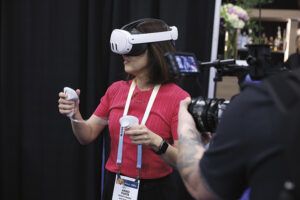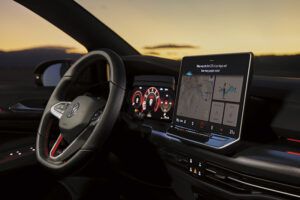The Tech-Techy Reservoir – From Y2K to CES 2024
Y2K – The Rise of the Internet
The year was 2000. AOL led the internet, and the idea of a personal computer was a Windows desktop displayed through a bulky monitor situated in a dedicated ‘computer room’. Phones were mere verbal communication devices with keypads and instant messaging was only possible through the desktop computer.
Internet browsing was very new and e-commerce sites such as Amazon and Netflix DVD rentals were just taking off. These were the humble beginnings of the behemoth digital world we are engrossed in, today. We were merely scratching the surface of what was humanly possible at the time.
Back in the early 2000s, technologists fantasized about internet streaming in devices that fit in our jeans pocket. The iPod was a revolutionary product putting “1,000 songs in [our] pocket.” Holograms, personal digital assistants, and giga-speed internet were still over a decade away.
Personal Computing Goes Mobile
The rise of fast-speed broadband connections brought forth the capability for instant communication on our mobile devices.
Let’s look back at the mid-2000s. QWERTY-keyboard-powered Blackberrys and simpler Motorola Razr flip phones held most of the market share. Laptops and PDAs were the new portable computing devices. For the Silicon Valley professional or college student, the internet and a personal laptop became a necessity to communicate with the world.
Towards the late 2000s, the concept of even more portable computing started taking center stage. Smaller laptops (netbooks), tablets, and powerful smartphones were the talk of the techies. A whole new market for mobile app development and mobile-friendly experiences was brewing. The trailblazing iPhones and Android-powered touchscreen phones were starting to gain popularity amongst tech-oriented prosumers.
Gone were the big bulky TVs and flat-screen HDTVs gave headway to realistic graphics on PS3 games. Blu-ray technology allowed for surreal colors and definition in the entertainment space. We were now in a new decade – 2010.
Suddenly, communication with the world transitioned from laptops to a pocket-sized device with a 4-inch touchscreen. 3D 4K TVs were about to be the next big thing in home entertainment and a new form of personal computing devices emerged. iPads bridged the gap between smartphones and laptops. Web/mobile applications were the new hot thing. “There’s an app for that now” was the new Silicon Valley lingo.
Looking back at the late 2000s and early 2010s, we were early adopters of modern-day digital communication with instant messaging and social media platforms on smartphones. As personal computing devices became more mobile and portable, we were amid the next big thing – the digital revolution.
2010s Onward – A More Virtual and Connected World
While Siri was just introduced and social media was taking the world by storm, my first interaction with a cloud-based networking application was through Google Docs and online gaming.
Google Docs was revolutionary because it allowed peers to edit documents simultaneously.
On the other side of the spectrum was Facebook and the rise of Instagram. These platforms served as networking platforms for people with similar interests to get connected and communicate.
Information started becoming available at the speed of light and all we had to do was tap a button for Siri, or say “OK Google.” All these digital interactions were powered by the virtual cloud and started the rapid development of what we know today as ‘Big Data’.

Rapid advancements in cloud computing have spurred many present-day mainstream technologies. AR/VR, IoT devices, autonomous vehicles, and the exponential advancement of AI and ML technology.
From Physical to Virtual – Going Forward
The last 20 years have been a showcase for technological feats. Everything from the internet to the smartphone, to VR headsets. We’ve seen it all… or so we thought. Generative AI says otherwise, ushering a new avenue for school children to get their homework done.
This nascent form of AI took 2023 by a storm, fueling the expectations of techies around the world that it’d be left, right, and center at CES 2024. And who would’ve guessed, it most certainly was. CES 2024 truly put on a show of what’s to come throughout the remainder of this decade, and here is a quick recap of the up-and-coming consumer innovations that caught our eye.
A/V Tech
We have seen LCD panels evolve into MiniLED TVs that you see today crowding your local Best Buy. Samsung’s solution to the limiting factors of an LED-backlit TV is MicroLED TVs and has finally made one that can fit in the living room. This display tech doesn’t need a backlight, as each pixel is self-lit. What does all this jargon mean? Such a screen can get exceptionally bright, with the best color contrast in a TV, all while delivering perfect black levels.
Remember Sharp? Well, they are back in the headlines for featuring the first-ever QDEL display. I’ll keep it simple, the best color purity and brightness, perfect black levels, brighter than OLED, relatively cheap to produce; I could go on and on. It’s a truly phenomenal piece of tech, and we don’t use that word lightly around here.
Dolby took surround sound to another level when introducing Atmos back in 2012. Innovative as it was, optimal sound relied heavily on speaker placement. Now, Dolby announced Dolby Atmos FlexConnect, allowing for compatible TVs to work with wireless speakers that can be placed anywhere and let AI do the hard work. Ah yes, AI has arrived.
Food Tech
A few years back if you would’ve asked me if we would have smart kitchen appliances using an artificial brain to cook food, I would’ve asked you to quit messing with me and help me with my Musical.ly. Yet here we are. We now have food appliances armed to the teeth with AI. Also R.I.P. Musical.ly, the OG TikTok.
The first product up in the running is the Seergrill Perfecta, a smokeless, electric, and propane-powered grill. They claim to produce perfect results every time with AI learning your taste preferences. At least, it is more energy efficient than an air fryer and the process only takes 90 seconds. This might finally be the microwave killer we were looking for.
Barsys announced the 360, an app-based mixologist packed into a tabletop kitchen gadget. Equipped with 6 liquid reservoirs, it can make a variety of drinks. Built-in recipes or personal recipes, your drink will be concocted in about 15 seconds.
Sevvy Smart Cooker boasts a revolutionary technique to cook food, using electrical currents to cook the dish more efficiently, evenly, and tastefully. Using this, no cooking fat is needed, and everything is done with half the sugar and salt while retaining 40% more nutrients. Sounds a little perfect, right?
AI in Automotive
AI has also slithered into the automotive industry as well. With Volkswagen implementing ChatGPT into their latest models, BMW showcasing its own LLM, and Mercedes embracing an AI-powered assistant, you really can’t get away from them, can you?

It’s not all AI though. Hyundai announced the Mobis which can turn any wheel towards any direction. Not Sci-Fi enough? Supernal has a S-A2 EVTOL aircraft, with space for 4, a top speed of 120, and can take off vertically. Mind-freaking-boggled.
Takeaways
The age of concrete innovation has been outshined by the rise of AI. CES is always brimming with state-of-the-art technologies, with companies showing off all that can one day be in our hands… or on our faces. This year was no different as CES showcased many new products in the personal electronics space. Be it the latest and greatest of TV tech or a pet ball named Ballie, there are significant hints of AI at every corner of this conference.
We believe that there will always be breakthrough innovations to keep us tech junkies at the edge of our chairs and the next few decades will unleash the full potential of man and machine. So here’s to more great innovations to keep us on our toes. Rest assured, Siliconeer will be there to map it out.
![]()
Co-author:
Vansh Gupta is Gen-Z Editor and Head of Digital at Siliconeer.
As we head into our 25th year of production, browse through our years of archives.


